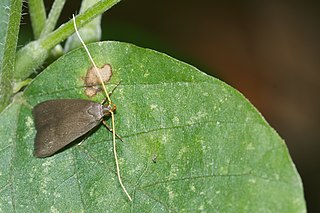Related Research Articles

The Lecithocerinae are a subfamily of small moths in the family Lecithoceridae. They are found worldwide, but most species occur in South Asia. The subfamily is characterized by the male genitalia with a bridge-like structure connecting the tegumen and the valva, and the uncus almost always is vestigal with two lobes at the dorsal base, only exceptionally united into a broad plate, but never as a thorn or spine.
Tamsica is a genus of moths of the family Crambidae.

Tisis is a genus of small moths in the family Lecithoceridae. The genus was erected by Francis Walker in 1864.

Candalides hyacinthina, the varied dusky-blue, is a species of butterfly of the family Lycaenidae. It is found along the east coast of Australia, including South Australia, New South Wales, Western Australia and Victoria.
Agonopterix taciturna is a moth in the family Depressariidae. It was described by Edward Meyrick in 1910. It is found in the Himalayas, the Russian Far East and Japan.
Parelliptis scytalias is a moth in the family Lecithoceridae. It was described by Edward Meyrick in 1910. It is found in Sri Lanka.
Tisis argyrophaea is a moth in the family Lecithoceridae. It was described by Edward Meyrick in 1910. It is found on Borneo.
Tisis charadraea is a moth in the family Lecithoceridae. It was described by Edward Meyrick in 1910. It is found in Malaysia.
Tisis eurylampis is a moth in the family Lecithoceridae. It was described by Edward Meyrick in 1910. It is found on Borneo.
Tisis hemixysta is a moth in the family Lecithoceridae. It was described by Edward Meyrick in 1910. It is found on Borneo.
Tisis imperatrix is a moth in the family Lecithoceridae. It was described by Edward Meyrick in 1910. It is found on Borneo.
Tisis cerambycina is a moth in the family Lecithoceridae. It was described by Edward Meyrick in 1926. It is found on Borneo.
Tisis polemarcha is a moth in the family Lecithoceridae. It was described by Edward Meyrick in 1926. It is found on Borneo and Sabah.
Tisis polychlora is a moth in the family Lecithoceridae. It was described by Edward Meyrick in 1926. It is found on Borneo.
Tisis isoplasta is a moth in the family Lecithoceridae. It was described by Edward Meyrick in 1929. It is found on Java in Indonesia.
Tisis helioclina is a moth in the family Lecithoceridae. It was described by Edward Meyrick in 1894. It is found in Myanmar.
Lecithocera ichorodes is a moth in the family Lecithoceridae. It was described by Edward Meyrick in 1910. It is found in southern India.
Thubana nodosa is a moth in the family Lecithoceridae. It was described by Edward Meyrick in 1910. It is found in Malaysia.
Sarisophora tamiodes is a moth in the family Lecithoceridae. It was described by Edward Meyrick in 1910. It is found on New Guinea.
Bassarodes is a monotypic moth genus in the family Xyloryctidae. Its only species, Bassarodes siriaca, is found on the Solomon Islands. Both the genus and species were first described by Edward Meyrick in 1910.
References
- ↑ Savela, Markku, ed. (December 31, 2014). "Tisis hyacinthina Meyrick, 1910". Lepidoptera and Some Other Life Forms. Retrieved September 12, 2020.
- ↑ Transactions of the Entomological Society of London. 1910: 439.
| This article relating to the subfamily Lecithocerinae is a stub. You can help Wikipedia by expanding it. |